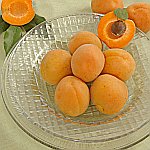|
|
 Apricots are an important fruit crop believed to have
originated in China and to have been brought to Italy about 100BC, reaching
England in the 13th century and America in 1720. The fruit is smaller than
a peach, colored orange-yellow when ripe, and with a drier flesh. Its food
value ranks higher than most common fruits.
Apricots are an important fruit crop believed to have
originated in China and to have been brought to Italy about 100BC, reaching
England in the 13th century and America in 1720. The fruit is smaller than
a peach, colored orange-yellow when ripe, and with a drier flesh. Its food
value ranks higher than most common fruits.
More than 20 kinds are distinguished. Some favorites are Moorpark, of English
origin, with a large, round, orange-red freestone, ripening in the middle of
the season; Newcastle, of California origin, with a medium-size, round,
orange-yellow freestone; and Royal, of French origin, with a large, oblate,
yellow-red freestone, ready early in the season.
The fruit, somewhat
smaller than a peach, is known for its delicate flavor. It is marketed fresh,
as well as dried and packed. Large quantities are canned or pulped for jam
making. California is the leading producers in the United States. It is also a
significant crop in British Columbia (Canada), Australia, Italy, the south of
France, and Israel.
How to Store:
To ripen apricots, place them in a closed paper bag at room temperature. Store
ripe apricots in the crisper bin of the refrigerator for one to two days.
Nutritional Facts:
· Low fat
· Saturated fat-free
· Sodium-free
· Cholesterol-free
· High in vitamin A
· High in vitamin C
· A good source of potassium
Detailed nutritional informatin can be found by searching the
USDA Nutritional Database
. Enter "Apricot" (no quotes) as the keyword and select the link and report of
interest.
Scientific classification:
The apricot belongs to the family Rosaceae. It is classified as Prunus armeniaca.
|
|